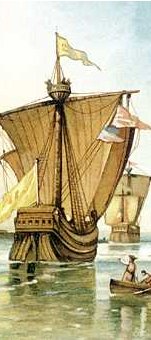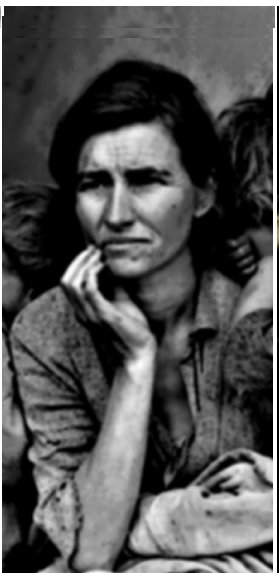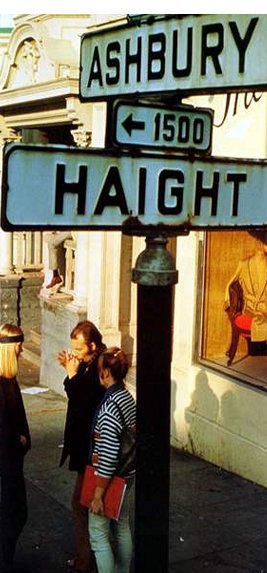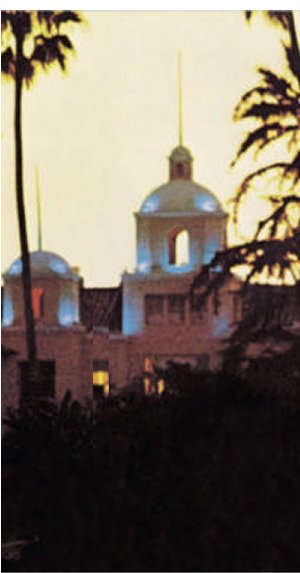
|Home| |Pre-American Settlement| |American Settlement--Civil War| |Late Nineteenth Century|
|Early Twentieth Century| |World War II and the Fifties| |Sixties--Present| |City Histories| |About|









 |
Welcome to the Bay Area Vortex Vince Vo
Charles Perry majored Middle Eastern studies while attending
Princeton University and the University of California, It would certainly be a model for
the world 1¡¨. Some say what happened at Haight -Ashbury should never
have happened, while many others argued that it was a hippie myth. Despite the
fact that there was various opposition towards this era, the Haight, a declining neighborhood
full of old buildings, old-fashioned stores, and damaged streets, was home to
thousands of state college students. It was also known for being a central
market for marijuana. In 1965, the Parties, clubs, and drugs attracted
people to the psychedelic lifestyle. A bohemian named Don Works created one of
the very first hippie saloons called the Red Dog Saloon. The night club led to
the formation of the rock-and-roll band, the Charlatans, whose Edwardian styles
of clothing influenced current fashions. As a result of the Red Dog Saloon, a
number of night clubs would open. Famous bands such as the Grateful Dead, the
Warlocks, Jefferson Airplanes, and the Holding Company came out from Haight-
Ashbury. Following nightclubs, people developed acid tests and light shows that
were intended to ¡§trip¡¨ the mind. The famous psychedelic, Ken Kessey created
acid tests. Basically, if a person could stay awake through a night of
partying and drug use, he or she passed an acid. The very first acid test
was held at a bookstore in There were organizers who set up these parties and events. Big shots such as, Ken Kessey, Billy Graham, Steward Brand, and Chet Helms were infamous psychedelics that hosted these parties. The Family Dog was one of the very first groups of organizers to set up large dances. They were responsible for setting up the huge public rock-and-roll dance known as ¡§A Tribute to Dr. Strange¡¨ which introduced thousands to acid tests. Kessey was well known as the expert on psychedelics. He bought the famous International harvester bus which he and his friends decorated with dozen of colors. While traveling across the country in the bus they had ¡§taken acid and acted as crazy as they felt, right out in public¡¨ (4). Therefore, Ken Kessey and the Merry Pranksters (what Kessey¡¦s friend called themselves) would travel across the country to host wild parties and spread ¡§peace¡¨. Kessey and the Pranksters influenced both outsiders and the psychedelic scene in Haight with their slogan, ¡§Freak freely.¡¨ Another group of organizers in Haight were called Mime Troupe. Instead of radical parties dealing with drugs and sex, the Mime Troupe had set up live music, puppet shows, art and neighborhood-appropriate entertainment. The puppet shows primarily dealt with anti-racism and politics. A new generation known as Diggers evolved from the Mime Troupe period and also devoted their events to peaceful terms. They stated that their intent as a group was to provide free food, shelter, repair garages, and a free ¡§ trip.¡¨Although these organizers had different views about the events they had set up, they were bonded by their community pride. As two years passed, the psychedelic scene began to decline. Drugs that were once legal had become illegal. Although the parties had gotten crazier and crazier, the police had also begun to intrude in the lives of the psychedelics. Police started arresting dealers, crashing night-long parties, and ending endless events. The frequent police visits gave the Haight scene a negative connotation. Many residents tried violent rebellions against the cops while others tried defending their rights peacefully. Ron Thelin of the Psychedelic shop wanted ¡§to show the police that hippies were good citizens, religious and nonviolent, and hope that hippies would lose their own stereotypes about police, he proposed that both sides get to know each other by putting up a ¡§Take a Cop to Dinner¡¨ sign in his shop window5¡¨. Despite efforts to improve relationships with the authority, there were more drug market busts than ever before. Police began daily sweeps of runaways on the streets of Haight. Psychedelic shops were in debt and the free store (set up by Diggers) was burglarized. Kessey believed that it was time to move on. He claimed that that didn¡¦t mean he would stop taking acid, but he wanted to do more than go to rock-and-roll parties. The announcement of the ¡§Death of Hippie ceremony¡¨ had a devastating effect. Though many knew that the movement was dying, others refused to believe it. When the memorial event took place on October 6, many did not attend because they chose not to believe that their hippie era was over. Despite focus on the Vietnam War,
the Haight -Ashbury scene was an immense topic during the 1960¡¦s. The story of Although a widely researched topic, the story of Haight Ashbury is incompletely told because the authors were outsiders who tried to describe a way of life they couldn¡¦t comprehend. As an individual who experienced every single detail during the psychedelic era, Perry reveals the truth behind the hippie lifestyle. ¡§Although his was by no means a remarkable history for those crowded days, his first-hand experience allows him to write about the era realistically7¡¨. The author of this book had not only been alive during the era of Haight, but had also roomed with Owsley Stanley, associated with Hell¡¦s Angels, known of the Red Dog Saloon, experienced the Acid Tests, and heard the Grateful Dead. His experiences led him to realize the true lifestyle of a psychedelic. To him, a life of a psychedelic in Haight did not only consist of endless parties, drug use, and free love, but also a protest against war and the an environment of peace. As a result, he had chosen to write a book that would completely expose the truth of a small psychedelic community that had a massive impact on popular culture around the world. Critics generally gave this book a
positive review; many who were interested in the era or who had lived during
the time believed that this novel had triumphed in explaining the truth.
According to critic Herbert Gold of ¡§Days of Magic and Disaster¡¨, he claims
that ¡§Mr. Perry has done his research, showing how the straight world, police,
media and churches reacted to the phenomenon7¡¨. Gold believes that
the success of this novel was constructed by the personal experience and
knowledge of the author. Indeed Perry has proven in his book that The Psychedelic phenomenon was perhaps the largest topic during the 1960¡¦s. The Haight neighborhood is filled with untold secrets and stories. People who are new to the subject may only know Haight by its music and drug scene. Many believe it was decadent and corrupt because of its reputation of wild parties and hippie related events. Perry has lived through the moments and associated with many of the individuals in Haight Ashbury. Therefore, his knowledge makes his novel a trustful encyclopedia of Haight. ¡§Confident of the Haight¡¦s historical role, and oblivious to the fissures within it, self-appointed spokesmen idealistically invited the world¡¦s attention and, unfortunately, got¡¨ (9). Although the psychedelic scene had lasted for only two years, it influenced the world. Not only in music and clothing, but also the lifestyle and traditions psychedelics believed in. The psychedelic scene in Haight
Ashbury took life beyond any other. With its introduction of acid tests, trip
festivals, hippie culture, and LSD, the lifestyle would create a huge impact on
the rest of the world. A police officer had said, ¡§The word is out that Perry makes his passion for Haight Ashbury clear.
Even though the hippie scene had ended after a short period, the community
hoped their message of peace and nonviolence would spread across the world.
While the hippie era searched for tranquility, ¡§what went on was farther than
ever from peace and flowers11¡¨. Many believe the events that
occurred at After the end the ¡§Death of
hippie ceremony¡¨, the psychedelic scene began to decline. Although some still
called themselves hippies, Haight disintegrated into an atmosphere of violent
and crime. Though this was the case, Haight managed to survive its bitterest
disappointments and most violent disruption. In succeeding to resolve its
problems, ¡§Haight was again an example of the world, an example of what could
be done if people decided to stick it out when things got tough in their
neighborhood12¡¨. This was exactly what Charles Perry was trying to
make known through viewers. Through a blend of optimism, nationality,
opportunism, and distinctive historical event, he wanted the world to see how a
small neighborhood took matters into their own hands and created a
revolution. More importantly, he had hoped the rest of the
world would see what the psychedelic scene in 1. Perry, Charles. The Haight Ashbury. 2. Perry, Charles. 3. Perry, Charles. 4. Perry, Charles. 5. Perry, Charles. 6. Perry, Charles. The 7. Gold, Herbert. The New York Times. 12 August
1984.<http://query.nytimes.com/gst/ fullpage.html?res=9A07E0D71538F931A2575BC0A962948260&scp=1&sq=haight-ashbury+charles+ashbury&st=nyt> 8. Dalrymple, Marilyn. Amazon.com. 9. Perry, Charles. 10. Perry, Charles. 11. Perry, Charles. 12. Perry, Charles. |